Blogpost for January 14th
This morning we woke up to a missing Abdulai and spent about 15 minutes looking for him around town with Jazee and Kwbana. Then on our way to Bf he joined us. He left early to greet his late wife’s mother. At BF we had our typical breakfast and Buffloaf, which resembles a huge fried donut balls. They were excellent along with the omelets, coffee, Milo and another fried treat made out of bean flour, koshe.
It was the day of the NGOs, and abreakfast, we started our tour of some of the local NGO’s. On our way to our NGO tours, we got to experience Prof. Iddrisu’s rendition of Happy Birthday, which involves the insertion of “you will live for 100 years and achieve all your goals with happiness” to the tune of the original happy birthday song. It was a good laugh and was an excellent start to Li’s Birthday.
School for Life
The first NGO of the day was “school for life” that provides education to underserved communities in Ghana. Their goals are to give students a head start so they can quickly assimilate into the formal school system. They have had a presence in Tamale for 20 plus years and have been very successful. During our visit, we had a short description of what the organization does and watched a documentary. The documentary talks about the sacrifices many families make in northern Ghana to provide their children access to education. This often comes in the form of picking and choosing which children can go to school and which ones have to stay home and work on the farm or taking care of the elderly family. Labor of the household is a significant issue and a common barrier that prevents children from going to school. This is especially true when it comes to the girl-child because there is an expectation for them to take care of the family and children. Marriage also hinders the education of girls.
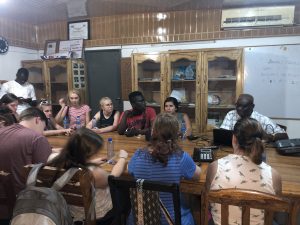
“School for life” is a community driven NGO created by the Danish government. Their goal is to reform the education system across all 50 districts in Ghana. The program requires that all classes have at least 13 girls out of 25 students in each class. The classes focus on reading, writing and also professional behavior. “school for life” makes all materials free so socioeconomic status does not prevent any children from learning. Additionally, the classes are taught in the local language so children can understand their education right from the start although English is still shown in the programs. School for life Serves 248,000 children, out of those children 91% have graduated and transitioned to formal school systems or on to higher education. Today there is more collaboration between the government and the school for life organization; however, funding is low. Only 1% of the GDP of Ghana goes to education, and even they’re not sure how much of that could be spent on those who had had no access to formal education. And Alhaji Karimu Mohammed, our speaker expressed that that was indeed not enough to reach their goals. They heavily rely on donations and help from other NGO’s such as Unicef. They’re however hopeful and urging the non formal education sector of the Ghana education service to work closely with School for life in achieving the MDG in providing access to education for all.
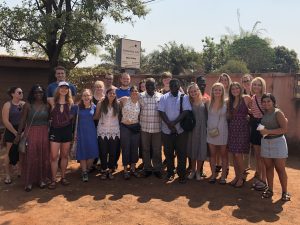
After the presentation we had the opportunity to ask questions, and here are a couple of the questions asked and their answers.
1. Where does the money funding these programs come from?
– UNICEF is one of the largest donors, the Danish government still provides aid, and the Ghanian government provides a small number of funds.
2. What are the largest problems you face?
– The most considerable challenges “ School for Life” faces are influencing the families to let their children go to school and the fact that they can only support classes of 25 children in each community which leads to many children still not receiving an education.
3. What’s the extent of involvement of Ghana’s ministry of education?
– In 14 districts there is high involvement of the government especially when it comes to funding, however as said before on 1% of the counties GDP goes to education most of which go to salary payments and not much might be left for our type of focus. But, we are still hopeful that the diatricts will continue to help us achieve our goal of “no child left behind” to steal of quote from our American system.
4. Are there any problems finding teachers?
– the more significant challenge is finding female teachers
– they must be able to speak the local language of the people and must have completed secondary/Snr High school. Sometimes these requirements are stretched in some areas. School for Life is a very successful program because they provide education at flexible times as well as schooling focused on agriculture and hygiene. School for life plays a significant role in identifying and combating gender inequalities which has increased the education rate of girls substantially.
Here is a link to their website if you want to check out the organization yourself.
http://lise98.wixsite.com/schoolforlife
Oxfarm/IBIS
After “School for Life” we headed down the street to OXFAM. OXFAM is an NGO that Advocates for global issues especially the ones covered in the MDG and SDG’s set by the United Nations. To name a few the organization is working in food security, inequities in society, education and closing the gender gap. OXFAM faces large funding problem because similarly to “School for Life” not a lot of the governments budget goes to the education of fixing inequities.

The discussion was focused on how OXFAM is fixing inequities in the youth community especially when it comes to education. Ghana’s government has the policy to create senior level schools, but many communities, especially in northern Ghana, do not qualify for the schools, OXFAM fulfills the human right of education to these communities.
OXFAM gives children a head start in these communities then move them to primary school much like School for Life, an NGO, they woke closely with. All their programs are taught in the native language and focus on reading and writing as well. There is a large amount of collaboration with school for life resulting in OXFAM being as successful as “school for life.”
Another project is to increase the awareness of the marginalization of young girls and through education. OXFAM works with state partners to identify the problems in the educations system, such as bullies and teachers that are not gender conscious. OXFAM combated these inequalities by creating a junior high school for only girls as a research project to see if girls were more successful if there were no boys present. This program was replicated in many district and was equally successful. When asked by one of us if this is the best solution, Mr. Wumbei Dokrugu, I tinted that OXFAM recognized that in the future this is not the solution, but for now, it’s the best model. The all-girl schools had very high success with of 100% pass rate. This resulted in OXFAM creating more all-girl school in communities. For equality, OXFAM also provides the same amount of boys schools as girls schools.
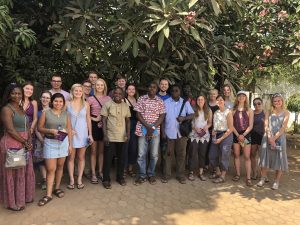
They are also taking their gender advocacy to the national level, stressing the fact that the inequities in the education world are based on gender inequalities. OXFAM also holds communities responsible for local issues . Especially in the decentralization of education. OXFAM is creating a network within the education community to shape policy, criticize policy and provide input on policy for the government primarily increase community involvement. OXFAM has been successful in making the government review the current textbooks and making them at the correct comprehension level so children can learn properly.
RAINS
Next, we went to RAINS where we met the program manager, Mrs Wedada. RAINS is a local organization formed by Ghanaians in the northern region who started to take on some of the challenges that Ghana was facing. Launched in 1993 it’s nonprofit that responds to developmental difficulties. RAIN’s started with the challenges of providing primary education that gave equal opportunity to boys and girls. RAIN’s has had a fair amount of success in the community, for example, they set up the first all-girl senior high school in Tamale. This is important because especially in the north girls are underrepresented in school and were vulnerable to many challenges such as child marriage.
Additionally, RAIN’s is trying to decrease poverty, give more economic power to women, provide a voice for children and spread awareness about how climate change affects agriculture. RAIN’s is a very successful NGO in the northern region, and it was fascinating because a woman ran it. Wedada is a benefitiary of the program, which helped her finished he university education and now has two masters degrees.
This is significant because it was the only time it was a woman in a position of power talking about fixing gender inequalities. Inequalities she experienced and overcame. She was very inspiring.

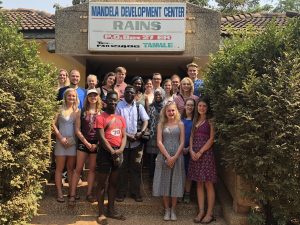
After the NGOs, we had a lovely lunch at our typical place. Today we had Jollof rice and spicy tomato sauce with fried chicken. After lunch, we had a crazy time trying to find some “American snacks,” but this wild goose chase led to the discovery that one of the essential chiefs in western Ghana was coming into Tamale today.
The Kumbungu Naa
This chief, the Kumbugu Naa, Abu Iddrisu, a retired director of the Survey Department, is the traditional war commander of the Yaa Naa, the overlord of Dagbon. So, it was a massive deal that he was coming through town. Prof. Iddrisu said that he was a warrior and one of his weapons was bees and that the bees follow him into war and wherever he goes. This was very interesting, and many of us wondered how that would work, but we noticed the bees are in a container carried by a bearer I front of the chief while he rides on a horse.
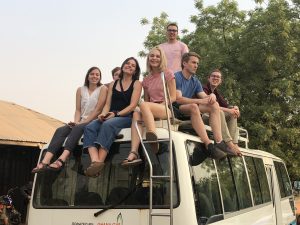
Tamale quickly turned into a large mass of people lining the streets and all stores were closed because of the arrival, and possible theft. We found a spot for our bus and waited for the chief to come by. It was a massive parade when the chief came near there were many men carrying machetes, bows & arrows, muskets and lots of dead chickens.
When the chief finally came near, he was riding a white horse dressed in all black with the bees in front of him in a large wood bin.
It was quite the affair, and Abdulai himself had never seen it before, and in his usual ease told us that “it’s not everyday the king of Dagbon dies.” The last time it was carried to Yendi at a Yaa Naa’s funeral was in 1974, but it was also carried to the only other funeral it comes out, in 2000, at the Yoo Naa’s funeral. It was not carried to Na Mohammed’s funeral in December was it’s carried only once in a year. It was a once in a lifetime experience, and many of us were shocked by what we just saw. The chief came into town because the overlord of Dagbon, Yaa Naa Yakubu Andani II had died 16 year previously and the funeral was being held in Yendy, a city 60 miles outside of Tamale and the Traditional capital of Dagbon. Chiefs from around northern Ghana have been arriving all week, and the funeral will host thousands of people. We are sadly unable to go because of the possible tension between the clans, but many of us were satisfied with today’s spectacle.
Happy Birthday 🎂 🎁 Li.
We ended the night with dinner and a quick birthday celebration for Li that included cake.

She expressed that she had never had a birthday like this and we all laughed and reflected on all we learned and experienced today.
